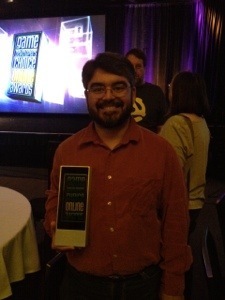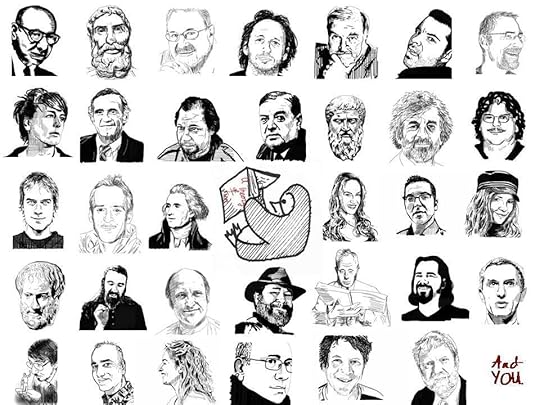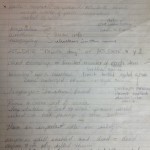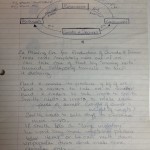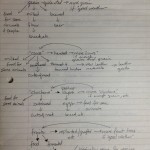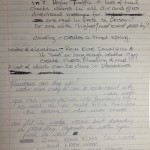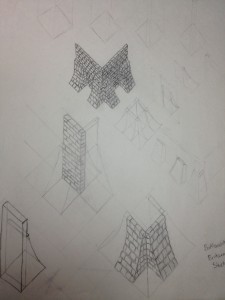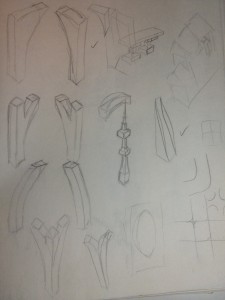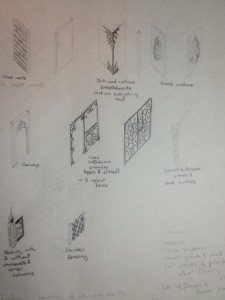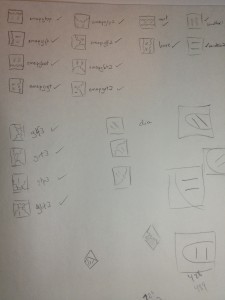Raph Koster's Blog, page 22
November 13, 2012
Keynoting GDC China

I’ve been sadly neglectful of this blog! In the last few weeks, particularly, because I have been fighting off some sort of nasty flu thing… still have a lingering cough, in fact, and it’s been more than two weeks!
So that meant that while I was flat out in bed, I missed the official announcement about the talk I am giving at GDC China this weekend. It’s been years since I was in Shanghai, so I am looking forward to this!
As far as what the talk is about… well, it’s sort of an extension of the lines of thought from the Project Horseshoe talk Influences and the GDC Online talk It’s All Games Now, and even a little bit from the Theory of Fun 10 Years Later talk. Basically, it’s about the patterns of thinking that games tend to encourage… and how these ways of thinking may be affecting us culturally. After all, if games do their work in large part via neuroplasticity, then that means that the cognitive habits we are picking up as gamers must be having an impact on how we think about, well, everything.
What might those cognitive habits be? And what impact might that have?
It’s a keynote, and supposed to be “inspirational,” so it’s in a lot of ways a rather light treatment of the subject… but I think there’s a lot to dig into there, and not all of it is unalloyed good… instead, it will be a picture of trade-offs. For example, just recently I read an article on how the neural pathways for empathy and the neural pathways of logical thinking seem to be mutually exclusive; you can’t do both at the same time. You have to emotionally detach yourself to be able to do true systems analysis, but if you are conditioned to approach the world analytically, does this mean that you are conditioned to avoid empathy? Pure speculation, and of course the answer will not be clear-cut.
Anyway, here’s the details on the talk:
How Games Think
10:20-11:20 Sunday Nov. 18th
Raph Koster (Playdom/Disney Interactive)
Games change us. They change our brains, they change how we think.We live in a world where we have always been shaped culturally by literature, history, myth, art, and music. But now games are a dominant new medium. They bring with them ways of thinking. And that means that we, as humans, will literally think differently. We will see the world through the lens of games, and we will change the world using the tools of games.
It cuts both ways, because not all of the ways that games teach us to think are better — they are just different. And as a result, the world is changing in radical new ways.
In this talk, come learn how games think, and what that means for how we think, and what it means for our future.
October 11, 2012
GDCOnline: UO Classic Game Postmortem

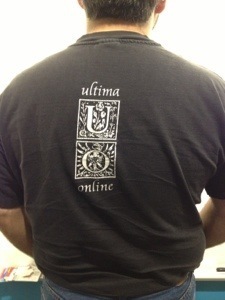 Well, we basically winged it, but it was a blast. We told stories, mostly out of order; fessed up to bad code and goofy decisions and being painfully young; and lamented the loss of that sens of crazy freedom.
Well, we basically winged it, but it was a blast. We told stories, mostly out of order; fessed up to bad code and goofy decisions and being painfully young; and lamented the loss of that sens of crazy freedom.
Luckily, Gamasutra has you covered if you weren’t in the full house.
In the alpha, the team had wolves that chased rabbits across the map as part of its emergent gameplay system.
In those early days, the rabbits would actually level up if they got into a fight with a wolf and managed to escape.
“People would wander off in the alpha and try to kill a rabbit, and pretty soon they were playing Monty Python: The MMO,” joked Koster.
The game was tweaked to disallow this, though Koster confesses that they left one monster rabbit in the world when the final game shipped.
I wore my original UO shirt… and forgot to point it out! Doh!
Basically, during the period when we were skunkworks and ignored by the company (it was mutual, we ignored them back) we did our own marketing. So that meant we made our own t-shirts with a made-up logo. And I still have that shirt, in surprisingly good shape for being from 1996. All credit to Clay Hoffman for making it, way back when…
GDCOnline: Online Game Legend

Last night i was given the Online Game Legend Award at the GDC Choice Online awards show. Rich Vogel gave a touching introduction. I think he was more nervous than I was!
This is a reasonable facsimile of the little acceptance speech I gave. The real thing was filmed and is up on twitch.tv or Gamespot somewhere… edit: Oh, here: http://www.twitch.tv/gamespot/b/335135808
I don’t feel like I deserve this, but i am happy to pretend that I do!
I want to thank all of those people whose credit I am taking, many of whom are here tonight. You know who you are. It’s 16 years worth of names and I can’t possibly say them all.
I do want to say some things that I have learned.
First, don’t make my mistakes. I’ve made many. You’ve played them. Make new ones.
Listen and learn, especially from your players.
Share it all back.
Don’t settle. Dare, instead.
Love what you do.
But a hard-won lesson here: Love your family more. Spend time with them too.
My mom asked me to say this: soy Latino. Most people don’t seem to know… So it can be done.
In theory I have more career years ahead of me than behind. I guess I’m going to have to come up with something new!
Thank you.
The award starts at minute 49.
October 10, 2012
GDCOnline: A Theory of Fun, 10 Years Later

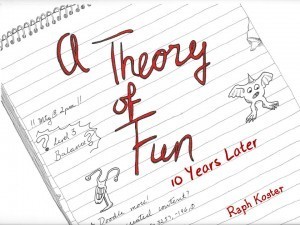 Here are the slides for the design track keynote I gave yesterday, as a PDF. Edit: thanks to Alexandre Houdent for providing a version of the PDF that works on all OSes…
Here are the slides for the design track keynote I gave yesterday, as a PDF. Edit: thanks to Alexandre Houdent for providing a version of the PDF that works on all OSes…
Among the topics: a recap of Theory of Fun, discussion of what I would change about it today, and all the thoughts it led me to: game grammar, games as art, games as math, the ethics of games, gamification, etc. With a dash of Classical philosophy.
I had the shakes bad before I started… but it felt like it came together in the end.
Apologies to anyone whose face I rendered unrecognizable. And the unlabelled woman is Jane McGonigal.
The press coverage so far:
Gamasutra has a detailed article
Games.com has an unfortunate headline, but a nice brief overview
PocketGamer.biz also has an in-depth piece
A challenge for you all: can you name all these people without peeking at the slides?
September 26, 2012
Mailbag: I want to become a designer


Dear Raph Koster,
I want to become a Game Designer.
As a child I used to judge games very harshly on things like graphics and funness. Although as I’ve grown older I’ve seen there is a lot more to games then meets the eye. I don’t want to sound all professional and stodgy, I’ve just reached the stage in my life where I need to choose my path. Whether it is the correct one will be with the help of you.
I want to be a Game Designer. There are courses at Universities specifically for Designing games or Programming for games, (programming is what I would want to start doing in the industry) although it feels like I’m just the same as everyone else who picked up a controller or keyboard and said “I can do better than this”.
Simply put I was hoping you could give me some advice on how to achieve my dream. The fun is in the learning as a well written book once taught me (wink wink), and the Gaming industry is ever growing.
Thank you for your time,
H_____ P_____.
Sure.
If you want to design games, you should start designing games. You can design games with a deck of cards. With index cards. And a pen, don’t forget a pen. You can do it with some poker chips, with some Lego bricks, with an old chess board. Your first lesson is “games are not their graphics.” Or their framerate. They are their rules. You can start making games with whatever you have to hand.
Learning programming is just going to give you a nicer set of index cards and blocks and chips and boards. It will let you use virtual stuff instead of real stuff. But the lessons you learn will work either way. If you can’t program yet, try GameSalad or GameMaker.
I would recommend that you learn to program. I would also recommend that you learn to draw. And to write. A designer needs to be able to communicate with people who do all these things for a living. That will likely mean drawing something to explain it to the artists, and writing something to explain it to the marketers and it might even mean programming something to show a programmer what you are trying to do. You don’t need to get really good at any of these things. Just get good enough.
Don’t choose a narrow education. Choose a broad one. History, economics, psychology, art, science. A classic liberal arts education is the best training for a designer.
Play games. But break them down as you do it. Don’t play for fun, play for analysis.
When you do sit down to start a game, you are probably starting with an idea. The idea is probably either an idea about rules, or an aesthetic idea, an experience. Whichever one you started with, go figure out the other one. Make sure they line up well together. Decide what your game is about.
Read or watch all these things, which are all free (and none of them are here on this site!)
Ian Schreiber’s Game Design Concepts class and Game Balance Concepts.
Clint Hocking’s article on ludonarrative dissonance
Dan Cook’s Chemistry of Game Design article
Whatever free videos in the GDC Vault tickle your fancy
This episode of Extra Credits.
I could say more, but I think I just gave a twenty year to-do list. Well, the reading will be done faster than that, but hey, there’s always lots more to read. 
September 25, 2012
The Gametrekking Omnibus

A long while ago, I pointed readers of the blog towards Freedom Bridge, a notgame about Freedom Bridge.
I also later mentioned that the creator was doing a Kickstarter to go off for a few years and live in Asia and make games like these about his experience.
I just got email from Jordan Magnuson letting me know that not only was the Kickstarter funded, but he’s done!
I just wanted to let you know that the project was successfully funded, and as of today, is officially concluded… I’ve released a downloadable collection of all my Gametrekking creations (along with a brief retrospective) at http://www.gametrekking.com/blog/the-gametrekking-omnibus-and-a-brief-retrospective
I have not been able to dive deeply into all of it yet, but what I have played can only be described as poetic.
I hesitate to say “enjoy!” — so let me rather say, go look, experience, and appreciate.
Ultima Online is fifteen

Today was the fifteenth anniversary of the launch of Ultima Online. For those who would like to read up on some of the stuff I have written in the past, you can do so by clicking here. Warning: rambling ahead…
Here’s something that I think no one has ever seen. My wife and I were driving from Alabama (where we were in grad school) to Austin, to visit friends there — Sherry Menton and Rick Delashmit. All four of us worked together on LegendMUD.
Kristen and I had been talking about making another mud, one with deeper simulation elements. We talked about having abstract properties running behind things, instead of hard-coding every quest. How much cooler would it be, we thought, if the NPCs were simulated entities, rather than merely responding to player actions?
We took notes on a pad of paper, as we drove. We took turns, which is why the handwriting in these images changes:
One of those pages has the old address of Ancient Anguish, a mud we were checking out. It’s still up. As you can see, a lot of the heavy lifting was done by my wife, the economist.  Some of this stuff ended up making it into LegendMUD — the weather stuff, for example. You also see there the notes on the genesis of the moods system that was first in Legend, then eventually in Star Wars Galaxies. It wasn’t until ’05 that I was able to do the water flowing downhill stuff, as part of an R&D project at SOE that was never used for anything. It worked, though.
Some of this stuff ended up making it into LegendMUD — the weather stuff, for example. You also see there the notes on the genesis of the moods system that was first in Legend, then eventually in Star Wars Galaxies. It wasn’t until ’05 that I was able to do the water flowing downhill stuff, as part of an R&D project at SOE that was never used for anything. It worked, though.
Here was born the resource system. When we were asked to submit design samples, the resource system is what we sent in. It was more elaborated than this, much closer to what was eventually built for the game. Then they asked us to submit quest samples. They had sent us some sample code, to ask if we could read and understand it. We could… and we weren’t very impressed by it. I sent in the Beowulf quest from Legend as my sample…
 An anecdote: We’re all meeting over the fact that we’re short on artists. It meant that we might lose the entire jungle biome.
An anecdote: We’re all meeting over the fact that we’re short on artists. It meant that we might lose the entire jungle biome.
I said to Starr, “If I can have a Wacom tablet, I can probably draw plants.”
Starr turned to Rick and said “Is he any good?”
Rick shrugged. “Yeah, he’s not bad.”
I got a Wacom tablet. And I did all of these. They were all drawn from issues of National Geographic that I brought in from home… that’s why there are several specifically Hawaiian plants there. Later, poor Chuck Crist had to go through and painstakingly remove the black edging from them — I hadn’t done them on a transparent layer.
That was far from the only art stuff I did on UO. All the design materials for UO went off to the lawyers when the lawsuit hit. It was a six foot tall stack of paper. I don’t actually think it ever came back. There was a printed out record of every patch. Design specs for everything. Detailed maps of every section of the world. For all I know, it is sitting in a legal file folder at EA somewhere… But I do have a few things from a sketchbook.
A lot of the time we were trying to solve problems like stairs, or buttresses. For those who recall the Mage Tower in Britain, I created the templates for arches and flying buttresses just for that building. Trinsic was the reason we got sloping walls at all. I also created the templates for how to do stairs, and later, sloping terrain.
The embankments, as we called them, were an interesting challenge. We had experimented with doing height as pure optical illusion… I had worked up a faked set of terrain tiles which just had lighter and darker sides and were impassable, to suggest slopes. The whole thing made the ground look ziggurat-like.
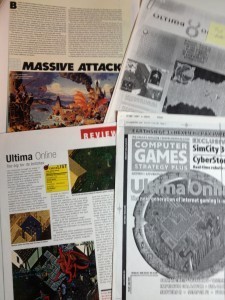 Then Rick Delashmit said he could probably actually give us texture-mapped terrain. But we needed a way to signal ravines and other slopes that were impassable… in particular, along the shorelines.
Then Rick Delashmit said he could probably actually give us texture-mapped terrain. But we needed a way to signal ravines and other slopes that were impassable… in particular, along the shorelines.
The result were the embankment texture sets — the fourth image above is presumably where I worked them out…
I used to actually draw isometric versions of structures, and even whole cities (I did for Serpent’s Hold) in order to plan out exactly where everything would go…
Eventually, of course, the game launched. And with it came a lot of press. I would be given faxed-in copies of articles from all over the world by the PR folks. Almost all of the reviews were middling to bad. 6 out of 10 was a pretty common score. (We did also get a pile of awards, including a couple for special achievement. We never got to see any of the trophies. They all went to EA HQ. I hear they are now all at Mythic).
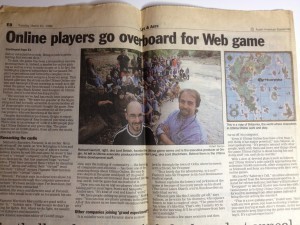 In one of these pics you can see the faxed-in cover of Computer Games magazine… I had been slaving for weeks over a very cool and much more elaborately built environment called Teratha. It was a spider-worshipping culture that built its city around a volcano. It became the cover image for the magazine article — and was cut from the game a little while later. I was devastated… but we had to make a lot of cuts… I mean, three whole continents were the first to go…! I remember sketching stuff out for the cultures of the Lands of the Dark Unknown — I think some of this eventually became stuff used in the Lost Lands and in Elikki and some other locales in Britannia. So if you ever wondered where these extra islands and whatnot came from… like Ocllo… well, now you know.
In one of these pics you can see the faxed-in cover of Computer Games magazine… I had been slaving for weeks over a very cool and much more elaborately built environment called Teratha. It was a spider-worshipping culture that built its city around a volcano. It became the cover image for the magazine article — and was cut from the game a little while later. I was devastated… but we had to make a lot of cuts… I mean, three whole continents were the first to go…! I remember sketching stuff out for the cultures of the Lands of the Dark Unknown — I think some of this eventually became stuff used in the Lost Lands and in Elikki and some other locales in Britannia. So if you ever wondered where these extra islands and whatnot came from… like Ocllo… well, now you know.
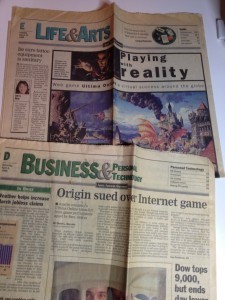 I also got a dozen or so emails and letters from fellow developers across the game industry — from Meridian 59, from Blizzard, from LucasArts and Bioware, full of praise. I printed them out and tacked them up on my office door. Marketing folks then asked me if they could use them in press materials and I told them no, they were never meant for the public. I still have those print-outs — and I am still not sharing them with you.
I also got a dozen or so emails and letters from fellow developers across the game industry — from Meridian 59, from Blizzard, from LucasArts and Bioware, full of praise. I printed them out and tacked them up on my office door. Marketing folks then asked me if they could use them in press materials and I told them no, they were never meant for the public. I still have those print-outs — and I am still not sharing them with you.
 And then, of course, came the lawsuit.
And then, of course, came the lawsuit.
The lawsuit was, as I recall, over the fact that the game was advertised as being available 24/7. But it was crashing, and therefore not always available. So a lawyer who went by the game handle “Bunboy” sued us. And his lead plaintiff, amazingly enough, was someone that I already knew: a LegendMUD player who had been a administrative challenge for years. In short, a problem player from one game had followed us to another game!
By then, Kristen was staying home with our second child. We had brought our first born, our daughter, into the offices with us. Every single person on the UO team had either quit, moved back to Ultima IX, or moved over to the already begun UO2. I was the only person left.
Origin asked us for an expansion. We had to use the empty space left on the edge of the map. All that would fit was a small chunk that I sketched out to mimic a portion of Ambrosia from Ultima III. We hired a few new folks — Chris Mayer (Faceless), Runesabre (Kirk Black)… I think it was a team of six, plus some of the folks who had quit working on contract, and we made The Second Age in three months.
The EA lawyers were very unhappy with me over a quote from that newspaper article in the pic. I ended by saying UO was “a grand experiment.”
They said “don’t you realize that’s the sort of thing they will use in court against us?”
But it was. Grand.









September 17, 2012
OGDA meeting

On Saturday I met with the Omaha Game Developers Association in a Google Hangout for a couple of hours of interview-style questions. The whole thing was streamed live on YouTube and also captured afterwards, so here it is for those who have the patience.
Among the things we talked about:
how I got into gamestext mudsearly UO historyuse of metrics in SWGformal design tools and game grammarempathizing-systemizing theory (and related tests)ludonarrative dissonance (hat tip to Clint Hocking)And way more… vid after the break.
OGDA interview with Raph Koster









September 6, 2012
GDCOnline: revisiting A Theory of Fun

So the third thing I will be doing at GDCOnline has now been announced:
A Theory of Fun 10 Years Later
Design | 60-Minute | Track Keynote | All
TBDTen years ago, at the very first Austin Game Conference, online gaming pioneer Raph Koster delivered an inspiring keynote on why games matter, how they teach players, and what fun is. That talk served as the foundation for his valuable book, A Theory of Fun for Game Design, challenging game makers to build entertaining, engaging, and addictive experiences. Now, for the tenth anniversary of his presentation, Koster will revisit A Theory of Fun to discuss what has changed in the science and the theory in the intervening years.
Yup, this is actually the tenth anniversary of the original Theory of Fun talk. Hard to believe! I think most did not become aware of it until I reprised it as the keynote of the Serious Games Summit at GDC the next year… And then, of course, the book also followed later that year too.
Needless to say, this little talk, the cartoons for which were hastily scribbled the night before, changed my life in many ways. One of the highlights of my life is the number of young folks who come up to me to tell me about their experiences with the book and how it shaped their notions about our medium.
Credit where it is due: the talk would never have happened were it not for conversations with Dave Rickey an Noah Falstein. (The book has a whole other set of midwives).
For anyone who hasn’t seen them, the original slides are here. I have to come up with a new presentation format this time around. 









August 30, 2012
Online Game Legend


Today the press release went out announcing that I was selected to receive the Online Game Legend Award at the GDC Online Choice Awards. This award is voted on by fellow developers, and it’s basically a lifetime achievement award.
The Online Game Legend Award recognizes the career and achievements of one particular creator who has made an indelible impact on the craft of online game development.
This rather leaves one thinking, “Well, now what?”
(Warning: introspection ahead…)
I feel deeply ambivalent about it. As I write this, I am just 40 years old. (I will be 41 by the time they actually hand me the physical award, though). In theory, I have quite a lot more years ahead of me in my career than I do behind me. The previous winners are Dr Richard Bartle, and John Taylor & Kelton Flinn. I would have expected that people like Randy Farmer & Chip Morningstar, or Mark Jacobs, or Gordon Walton, or Jessica Mulligan, or other pioneers would have gotten the nod before me…
I am also keenly aware that this award is likely being given as much for things I have written as for games I have made. And that feels odd. I don’t, after all, have that long a list of game credits — particularly not ones that I actually got my hands dirty on, as opposed to sitting in some management role at a fair distance.
It doesn’t help that the last really big, ambitious, passion project thing I tried to do, Metaplace, didn’t really click. Oh, it was a success, in the end, in terms of technology and in terms of financial rewards, but it didn’t do what I had been dreaming of for ten years. It didn’t even do what those few users who passionately believed in it had hoped.
Instead, the players pretty much see one game in ’97, one game in ’03, and maybe, if they noticed, a webby thing they dismissed, in 2007. There’s certainly plenty of folks who would be happy to tell you that I haven’t made an MMO in ten years. Or that I have “sold out.”
And then I can’t help but think of all the things that people don’t know I did, because they have never seen the light of day. The tech that allowed for worlds dynamic enough that rivers flowed, you could push through snow banks, and water the earth to have plants grow. The dozen or more puzzle games — in working prototype! — that sit entangled in various legal ownership questions. The (let me count now…) four or five full worlds’ worth of lore, stories, and high level design that cost me several years worth of working time, that all belong to cancelled projects: the city that was the ur-city at the heart of all stories, ruled by an ancient heptarchy; the planet made of sentient crystal where the colonists’ collective unconscious began to manifest as creatures and powers and new selves; the cartoon world full of aliens with unpronounceable names that was an homage to cheesy raygun-and-rockets space opera… The board games I have never gotten around to releasing in any way. The game design theory I have not finished writing down for lack of time and because of contractual obligations. I have an awful lot of stuff on the shelf, and who knows how much of it will ever be seen by players and colleagues.
Oh, but there are the novels I haven’t written. The fantasy and science fiction stories that sit on my hard drive. The 250+ songs I have composed and never perform. The poet I might have been. The unused art supplies that litter my shelves. The things that I have not done because of what I have done; and how often I would rather have done what I did not. It is odd to get this award when you don’t really feel that productive.
I’m not kidding myself; after all, my ego is quite healthy. I knew this would happen, someday. There’s plenty of folks out there who will be happy to tell you about my arrogance, just search any MMO forum!
I just didn’t expect it… yet.
And really, it arrives at a time when I am in need of validation. So I feel grateful, and honored, and flattered, and humbled. And discombobulated, and pensive.
I keep catching myself thinking that it must be a hoax or practical joke, and then some other email arrives and I have to realize all over again that it is real…
(For those keeping count, this is the second of the three things that I will be doing at GDC Online this year: accepting this award on stage).










